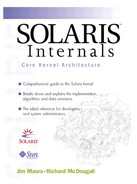2.1. Access to Kernel Services
The Solaris kernel insulates processes from kernel data structures and hardware by using two distinct processor execution modes: nonprivileged mode and privileged mode. Privileged mode is often referred to as kernel mode; nonprivileged mode is referred to as user mode.
In nonprivileged mode, a process can access only its own memory, whereas in privileged mode, access is available to all of the kernel's data structures and the underlying hardware. The kernel executes processes in nonprivileged mode to prevent user processes from accessing data structures or hardware registers that may affect other processes or the operating environment. Because only Solaris kernel instructions can execute in privileged mode, the kernel can mediate access to kernel data structures and hardware devices.
If a user process needs to access kernel system services, a thread within the process transitions from user mode to kernel mode through a set of interfaces known as system calls. A system call allows a thread in a user process to switch into kernel mode to perform an OS-defined system service. Figure 2.1 shows an example of a user process issuing a read() system call. The read() system call executes special machine code instructions to change the processor into privileged mode, in order to begin executing the read() system call's kernel instructions. While in privileged mode, the kernel read() code performs the I/O on behalf of the calling thread, then returns to nonprivileged user mode, after which the user thread continues normal execution.
Figure 2.1. Switching into Kernel Mode via System Calls

